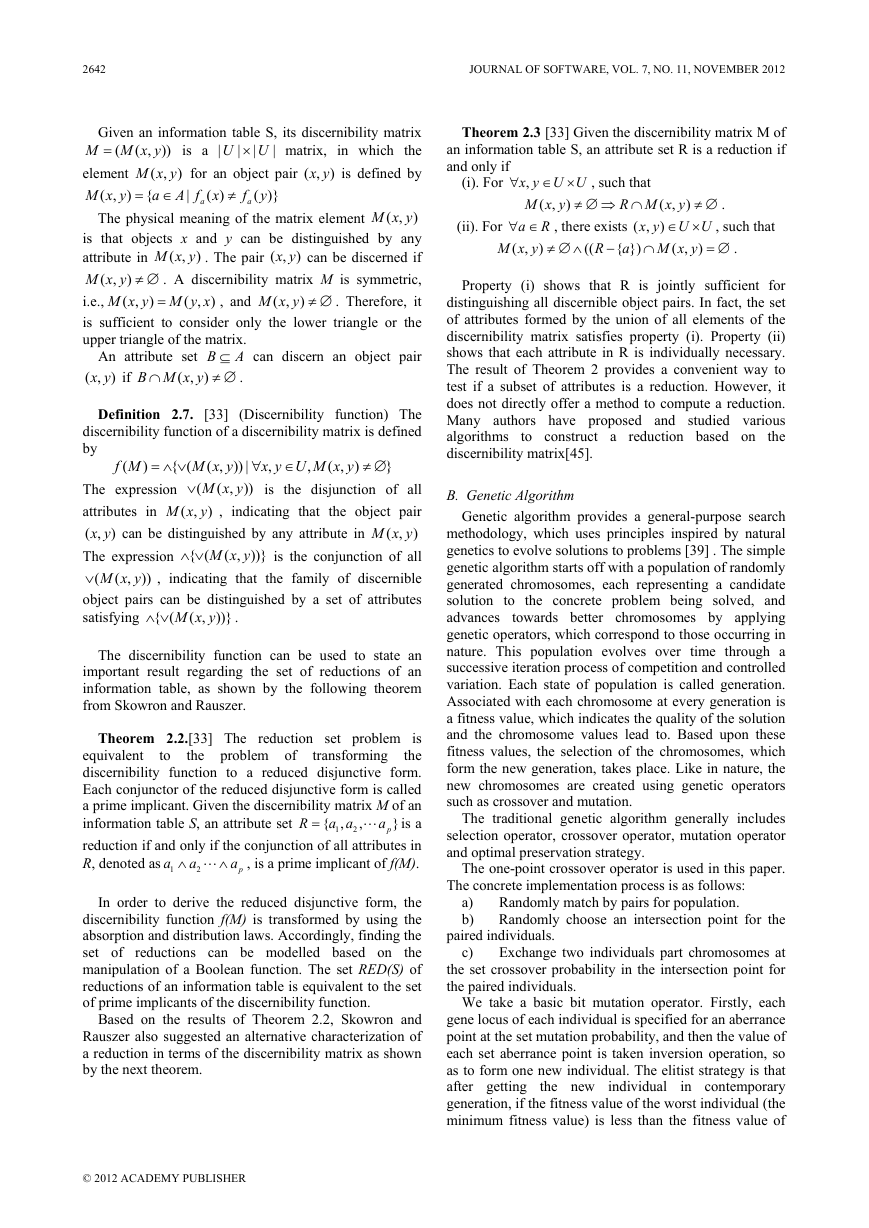An Attribute Reduction Algorithm Based on
Genetic Algorithm and Discernibility Matrix
School of Computer Science and Technology, Henan Polytechnic University, Jiaozuo, China
Wu Zhengjiang, Zhang Jingmin and Gao Yan
Email: {wuzhengjiang, gaoyan}@hpu.edu.cn
Abstract—In order to effectively solve the problem between
genetic algorithm convergence and a local optimal solution,
this paper presents an attribute reduction algorithm based
on genetic algorithm with improved selection operator and
discernibility matrix. In the algorithm, from the point of
view of granular computing, rough set decision tables based
on partition and covering are researched by measuring
granularity again. The practical results show that the
average convergence generation of modified algorithm is
obviously superior to not modified algorithm, which is
generally applicable in rough set decision tables based on
partition and covering
Index Terms—rough set, genetic algorithm, discernibility
matrix, selection operator, attribute reduction
I. INTRODUCTION
Rough set theory proposed by Pawlak in 1982 is a
mathematical theory that deals with imprecise and
uncertain information [1]. It provides a systematic
approach for classification of objects
through an
indiscernability relation. Many examples of applications
of the rough set method to pattern recognition, expert
system, medical diagnosis, environmental science,
biochemistry, chemistry psychology, conflict analysis,
economics, process control, and elsewhere can be found
in [2-7]. The further investigation into rough set theory
and its extension will find new applications and new
theories [8].
The classical rough set theory is based on equivalence
relations, but this requirement is too restrictive for many
applications. Therefore, rough set theory has been
extended to similarity relation [9], tolerance relation [10],
arbitrary binary relation [11, 12-15], covering [16-17] and
others [18-20].
The notion of a covering generalized rough set is
regarded as a meaningful extension of the traditional
rough set model to deal with more complex practical
problems. The literature [16-17, 21-32,46] has already
provided several models of covering based rough sets.
Multiple fuzzy rough set models based on coverings have
been established by some researchers [18-20].
In rough set theory, the attribute reduction is one of the
most important research contents. Most of attribute
reduction algorithm base on discernibility matrix deve-
loped by Skowron and Rauszer [33-35], Both the rows
and columns of the matrix correspond to the objects. An
element of the matrix is the set of all attributes that
distinguish the corresponding object pairs, namely, the set
consists of all attributes on which the corresponding two
objects have distinct values. One can construct a Boolean
discernibility function from a discernibility relation, with
attributes as Boolean variables. Skowron and Rauszer [33]
showed that the set of attribute reductions are in fact the
set of prime implicants of the reduced disjunctive form of
the discernibility
logic
foundation for the study of reducts. On this basis, many
researchers studied reduction construction by using the
discernibility information in the discernibility matrix [25],
[36], [8] and [10]. The attribute reduction of covering
rough set, one of rough set extension models, can also
adopt discernibility matrix, such as Tsang[4] etc proposed
a covering attribute reduction algorithm on basis of
discernibility matrix.
function. This provides a
in
is
its
this paper
to guarantee
The prerequisite for reduction that is called the weak
reduction
invariant
classification capacity of knowledge base. In practice, we
often hope to can ensure this prerequisite, K-nearest
neighbor (KNN) is an effective and powerful lazy
learning
easy-to-
implement. KNN is to find the nearest k neighbors for a
query point from a given data set and is widely used in
pattern classification applications [37, 38]. Therefore, we
can evaluate the quality of weak reduction through the
accuracy in KNN model.
notwithstanding
algorithm,
In knowledge discovery, genetic algorithms have been
used for classification, model selection, and other
optimization
tasks. Practically, genetic algorithms
provides a general-purpose search methodology, which
uses principles of the natural evolution [39]. It can
effectively solve the problem of large scale, complicated
structure, and low computational efficiency. Therefore, it
is suitable to solve this kind of questions like NP-hard
reduction. Genetic algorithm is firstly used for solving the
rough set attribute reduction by Wroblewski in literature
[40], after, many scholars have studied one after
another[47]. So this paper proposes an attribute reduction
algorithm based on genetic algorithm and discernibility
matrix about rough set decision tables based on partition
and covering.
However, sometimes the algorithm above cannot
converge within 200 generations, so cannot get the global
optimal
that behavior and
performance of genetic algorithms are directly affected
solution. We know
2640JOURNAL OF SOFTWARE, VOL. 7, NO. 11, NOVEMBER 2012© 2012 ACADEMY PUBLISHERdoi:10.4304/jsw.7.11.2640-2648�
by the interaction between their parameters [41], which
have fixed values in the simple genetic algorithm [42].
Therefore poor parameter settings usually lead to several
problems such as premature convergence. So we can
consider the three basic genetic operator (selection
operator, crossover operator and mutation operator) to
solve this problem, How to choose these parameters will
directly affect the algorithm performance and search
speed. This paper used improved selection operator
increases the probability of the algorithm convergence in
the global optimal solution, and thus don’t easily fall into
the local optimum. Following the modified instruction the
average convergence algebra is improved.
The rest of the paper is organized as follows. Section 2
reviews some basic concepts of the Pawlak’s rough set
and genetic algorithm. Section 3 describes the attribute
reduction algorithm based on genetic algorithm and
discernibility matrix. The
is
described in Section 4. Section 5 presents the examples
and analyses of the algorithms, the relationship and
performance analysis of the two algorithms are studied
and tabulated in each section. Section 6 concludes the
paper.
improved algorithm
II. PRELIMINARY
In this section , we briefly introduce the basic ideas of
rough sets, genetic algorithm and K-nearest neighbor
algorithm.
A. Rough Set
,
)
I
the decision
table. Rows of
to objects, and columns correspond
In rough set theory, the data is organized in a table
table
called decision
correspond
to
attributes. In the data set, a class label indicates the class
to which each row belongs. The class label is called as
decision attribute, the rest of the attributes are the
U A F is a knowledge
condition attributes. Let (
,
expression system. Here, A C D
= U , C is used to denote
the condition attributes, D for decision attributes, where
C D = ∅
. The knowledge expression system possessed
the condition attributes and the decision attribute is called
the decision table.
where
Pawlak defines rough set as following definition 2.1.
Definition 2.1.[43] Let U be a finite set and R be an
equivalence relation on U. R generates a partition
U R
the
equivalence classes generated by the equivalence relation
R. In the rough set theory, these are also called
elementary sets of R. Let ∅ denote the empty sets. For
any X U⊆ , we can describe X by the elementary sets of
R and the two sets.
R X
*(
R X
*(
)
Y U R Y
)
{
|
i
i
∩ ≠ ∅
Y U R Y
{
}
= ∪ ∈
i
i
= ∪ ∈
YL
, m
Y Y
{ ,
1
2
Y Y
2,
1
are
Y
}m
⊆
X
are called the lower and the upper approximation of X,
respectively.
L
X
=
}
,
,
,
|
Definition 2.2.[43] An
=
U A F ,where
U
)
,
,
triplet (
information system
x x
{ ,
1
2
is a
L is a nonempty
x
, }n
,
i
n
A
=
ja ,
j
ix ,
finite set of objects
1,2,...,
=
a
a a
}m
{ ,
,
,
discourse,
L
1
j
F
|
m
;
attributes
1,2,...,
=
of information functions such that
ix U∈ , where
called the universe of
is a nonempty finite set of
{
...,
1,2
,
is a set
=
=
V∈ for all
f x
(
)
i
j
jV is the domain of attribute
ja .
m
}
f
2
j
j
,
,
)
A⊆
Theorem 2.1. [44] Let (
U A F be an information
. The indiscernibility relation is
system and B
defined as
B
x x
R
{(
}
,
∀ ∈ .
=
i
B
BR is an equivalence relation, and produces a
Then,
partition on
x U x U f
,
i
f x
(
l
a
l
) |
∈
∈
x
i
),
=
(
)
,
j
j
l
j
:
[
x=
}
]
{[
x U
U U R
|
, in which,
∈
B
i
i B
x
R
]i B
x
x x
| (
)
,
{
}
=
∈
B
j
i
j
B f x
a
x
(
{
|
,
∀ ∈
=
l
i
f x
(
l
.
)
=
j
l
j
)}
The classical rough set analysis depends on the
indiscernibility relation that describes indistinguishability
of objects. Indiscernibility relations are equivalences that
are interpreted so that two objects are equivalent if one
cannot distinguish them by using existing information.
Definition 2.3.[44] Let (
,
,
,
,
)
U A F be an information
system and D A⊆ .D is referred to as a consistent set of
U A F if
(
. If D is a consistent set and
R
for all d D∈ , then D is referred to as a
D d
{ }
−
U A F . The set of all reductions of an
reduction of (
information table S is denoted as RED(S).
)
R
R=
R
D
≠
)
,
,
A
A
R
Since D
R
= ⇔
, the attribute reduce-
tion of an information system means it can preserve the
partition (classification) of the object set U.
U R U R
A
=
D
A
Definition 2.4. Let (
R
system and D A⊆ . if D
,
weak reduction of (
,
)
U A F be an information
,
,
R=
, the D is referred to as a
U A F .
)
A
Compared with reduction, the weak reduction defined
in this paper doesn't consider the minimum condition
attribute but considers only two object that have the same
classification ability.
Definition 2.5. [16] Let U be a finite universe of
discourse, C a family of subsets of U. If none of the
, C is called a
subsets in C is empty and C U
covering of U.
It is clear that a partition of U is certainly a covering of
U. and the concept of a covering is an extension of the
concept of a partition.
Definition 2.6.[33] Discernibility matrix. Two objects
are discernible if their values are different in at least one
attribute. Skowron and Rauszer suggested a matrix
representation for storing the sets of attributes that
discern pairs of objects, called a discernibility matrix.
∪ =
JOURNAL OF SOFTWARE, VOL. 7, NO. 11, NOVEMBER 20122641© 2012 ACADEMY PUBLISHER�
)
|
|
a
|
|
f
a
(
=
≠
U
( ,
( ,
( ,
y
( )}
U×
is a |
)
Given an information table S, its discernibility matrix
matrix, in which the
=
x y is defined by
M M x y
( ,
))
M x y for an object pair ( , )
( ,
element
a A f x
M x y
( )
( ,
) {
= ∈
The physical meaning of the matrix element
M x y
)
is that objects x and y can be distinguished by any
x y can be discerned if
attribute in
M x y ≠ ∅ . A discernibility matrix M is symmetric,
M x y ≠ ∅ . Therefore, it
i.e.,
is sufficient to consider only the lower triangle or the
upper triangle of the matrix.
( ,
M x y M y x
( , )
M x y . The pair ( , )
B M x y
( ,
A⊆ can discern an object pair
≠ ∅ .
An attribute set B
x y if
( , )
)
Definition 2.7. [33] (Discernibility function) The
discernibility function of a discernibility matrix is defined
by
)
( ,
, and
}
≠ ∅
x y U M x y
M x y
,
( ,
( ,
)) |
{ (
∀
= ∧ ∨
M x y
))
(
( ,
is the disjunction of all
The expression
∨
M x y , indicating that the object pair
)
( ,
attributes in
x y can be distinguished by any attribute in
M x y
( , )
)
The expression { (
is the conjunction of all
∧ ∨
, indicating that the family of discernible
∨
object pairs can be distinguished by a set of attributes
satisfying { (
∧ ∨
M x y
( ,
M x y
( ,
M x y
( ,
f M
(
))}
))}
( ,
∩
∈
))
.
)
)
)
,
)
(
The discernibility function can be used to state an
important result regarding the set of reductions of an
information table, as shown by the following theorem
from Skowron and Rauszer.
transforming
the problem of
Theorem 2.2.[33] The reduction set problem is
equivalent
the
discernibility function to a reduced disjunctive form.
Each conjunctor of the reduced disjunctive form is called
a prime implicant. Given the discernibility matrix M of an
information table S, an attribute set
L is a
reduction if and only if the conjunction of all attributes in
, is a prime implicant of f(M).
R, denoted as 1
a
a a
{ ,
1
to
}p
R
∧
=
a
a
a
,
p
2
2
∧L
In order to derive the reduced disjunctive form, the
discernibility function f(M) is transformed by using the
absorption and distribution laws. Accordingly, finding the
set of reductions can be modelled based on
the
manipulation of a Boolean function. The set RED(S) of
reductions of an information table is equivalent to the set
of prime implicants of the discernibility function.
Based on the results of Theorem 2.2, Skowron and
Rauszer also suggested an alternative characterization of
a reduction in terms of the discernibility matrix as shown
by the next theorem.
Theorem 2.3 [33] Given the discernibility matrix M of
an information table S, an attribute set R is a reduction if
and only if
(i). For
∀
,x y U U
∈ ×
M x y
( ,
)
(ii). For a R
)
≠ ∅ ⇒ ∩
x y U U
∀ ∈ , there exists ( ,
M x y
a
{ })
( ,
)
∩
R M x y
( ,
∈ × , such that
)
M x y
( ,
, such that
≠ ∅ .
= ∅ .
≠ ∅ ∧
((
R
−
)
Property (i) shows that R is jointly sufficient for
distinguishing all discernible object pairs. In fact, the set
of attributes formed by the union of all elements of the
discernibility matrix satisfies property (i). Property (ii)
shows that each attribute in R is individually necessary.
The result of Theorem 2 provides a convenient way to
test if a subset of attributes is a reduction. However, it
does not directly offer a method to compute a reduction.
Many authors have proposed and studied various
algorithms
the
discernibility matrix[45].
to construct a reduction based on
B. Genetic Algorithm
Genetic algorithm provides a general-purpose search
methodology, which uses principles inspired by natural
genetics to evolve solutions to problems [39] . The simple
genetic algorithm starts off with a population of randomly
generated chromosomes, each representing a candidate
solution to the concrete problem being solved, and
advances
towards better chromosomes by applying
genetic operators, which correspond to those occurring in
nature. This population evolves over time through a
successive iteration process of competition and controlled
variation. Each state of population is called generation.
Associated with each chromosome at every generation is
a fitness value, which indicates the quality of the solution
and the chromosome values lead to. Based upon these
fitness values, the selection of the chromosomes, which
form the new generation, takes place. Like in nature, the
new chromosomes are created using genetic operators
such as crossover and mutation.
The traditional genetic algorithm generally includes
selection operator, crossover operator, mutation operator
and optimal preservation strategy.
The one-point crossover operator is used in this paper.
The concrete implementation process is as follows:
Randomly match by pairs for population.
Randomly choose an intersection point for the
a)
b)
paired individuals.
c)
Exchange two individuals part chromosomes at
the set crossover probability in the intersection point for
the paired individuals.
We take a basic bit mutation operator. Firstly, each
gene locus of each individual is specified for an aberrance
point at the set mutation probability, and then the value of
each set aberrance point is taken inversion operation, so
as to form one new individual. The elitist strategy is that
after getting
in contemporary
generation, if the fitness value of the worst individual (the
minimum fitness value) is less than the fitness value of
individual
the new
2642JOURNAL OF SOFTWARE, VOL. 7, NO. 11, NOVEMBER 2012© 2012 ACADEMY PUBLISHER�
the best individual (the maximum fitness value) of last
generation, then the best individual of last generation
replaces the worst individual of contemporary generation.
So far, genetic algorithm have demonstrated impress-
ive results in a wide range of domains. However, it has
also been found that the genetic algorithm behavior is
strongly determined by the interaction between their
parameters, which have fixed values in the simple genetic
algorithm. Therefore poor parameter settings usually lead
to several problems such as premature convergence.
Genetic algorithm generally takes the roulette wheel
scheme to select. Although it is widely performed, it still
exist two problems. One is that in the early evolution,
there may be a fitness high individual is selected at a high
probability, thus reproduces many offspring, so it is easy
to appear the local optimal situation because a single
individual be unable to continue to evolve; The other is
that in the later evolution, when the gap of each
individual fitness is not big, this method is no longer has
the ability to select, so doesn’t reflect the superiority of
individuals.
Hence, this paper improves selection operator. Firstly,
select the individual directly into mating pool that the
fitness value is 1 from the initial population, and then
take the roulette wheel scheme. By taking this improved
selection operator, the individual number of the better
fitness value is increased, thus the above problems are
solved to some extent.
C. K-nearest Neighbor Algorithm
involves
The KNN method [37] is widely used in pattern
recognition. This method is useful both for estimation of
densities and for classification. As a classifier, this
algorithm
three steps: (1)
calculating the distances between a query sample and all
training samples, (2) choosing the k nearest training
samples to the query sample, and (3) assigning a class
label by applying the majority rule to the k nearest
samples.
the following
The process of KNN algorithm is as follows: given a
test document x, find the K nearest neighbors of x among
all the training documents, and score the category
candidates based the category of K neighbors. The
similarity of x and each neighbor document is the score of
the category of the neighbor document. If several of the K
nearest neighbor documents belong to the same category,
then the sum of the score of that category is the similarity
score of the category in regard to the test document x. By
sorting the scores of the candidate categories, system
assigns the candidate category with the highest score to
the test document x. The decision rule of KNN can be
written as:
f x
( )
=
arg max
j
Score x C
( ,
)
j
= ∑
d KNN
i
∈
sim x d y d C
) (
( ,
,
i
i
)
j
where
Score x C is the score of the candidate category
with respect to x;
)i
and the training document
) {0,1}
binary category value of the training document
f x is the label assigned to the test document x;
( )
jC
)j
( ,
sim x d is the similarity between x
is the
id with
y d C ∈
(
id ;
( ,
,
i
j
respect to
category
jC (
jC , or
1y = indicates document
y = ).
0
id is part of
This approach is effective, non parametric and easy to
implement. However, its classification time is long and
the accuracy is severely degraded by the presence of
noisy training document.
III. AN ATTRIBUTE REDUCTION ALGORITHM BASED ON
GENETIC ALGORITHM AND DISCERNIBILITY MATRIX
A. The Coding of Chromosome
,
=
C
c
}n
c c
{ ,
1
2
Considering the practical characteristic of attribute
reduction, the binary encoding is introduced. And the
coding strategy is as follows: let
L is the
condition attributes set, the condition attributes space can
easily map
the chromosome of genetic algorithm.
Chromosome is the binary string that the length is n, each
bit of which corresponds a condition attribute. If the bit is
1, which means select the corresponding condition
attribute,
the
corresponding condition attribute. For example, the code
0001100100001 shows the condition attributes of this
reduction have 13 bits and select the corresponding the
fourth, the fifth, the eighth and the thirteenth condition
attributes. Since binary encoding has the feature of simple
and convenient, in the whole, genetic algorithm in easy to
operate.
B. The Fitness Function
and otherwise means not
select
is
In the genetic algorithm, the fine level of the optimal
solution can be achieved by making use of the fitness
function which
individual’ s
optimization calculation in the groups. In this paper, the
fitness function is defined as follows:
to measure each
F x
( )
(1)
Where |
indicates the number of terms of discerni-
nC indicates the number of terms of dis-
bility function.
cernibility function that is covered by the chromosome n.
C. Selection Operator
|f
/ |
C
=
f
|
n
to
Take the roulette wheel scheme to select, we copy the
excellent individual selected from the contemporary
population
the next generation population. The
concrete implementation process is as follows:
a) Calculating the sum of all individuals fitness;
b) Calculating relative fitness of all individuals by type
(2), that is to say, the probability of each individual
inherits in the next generation
∑
n
i
1
=
L (2)
c) Taking the roulette wheel scheme to ascertain the
C x
(
i
F x
(
i
F x
(
i
1,2,
) /
),
=
=
n
)
i
times of each individuals selected
D. Algorithm Description
According to the analyses above, an attribute reduction
algorithm based on genetic algorithm and discernibility
matrix is described as follows:
JOURNAL OF SOFTWARE, VOL. 7, NO. 11, NOVEMBER 20122643© 2012 ACADEMY PUBLISHER�
The weak reduction is called advantage weak reduction
which more than the original accuracy of k-nearest
neighbor. The weak reduction is called reliable weak
reduction which greater than or equal the original
accuracy of k-nearest neighbor.
Algorithm 1(also shown in figure 1):
Input: a decision table
,
,
where C is the condition attribute, D is the decision
attribute
S U A V f A C D
= U
Output: one or more advantage weak reduction
Step 1: Calculating the number of terms of discernib-
),
=
(
,
,
ility function |
|f
.
Step 2: Initializing the population: randomly generate
m numbers initial population that length is n
Step 3: According to the type (1) to calculate the
fitness value of each individual, if the fitness values of all
individuals are 1, turn to step 9
Step 4: By type (2) to calculate the probability of each
individual selected, and then taking the roulette wheel
scheme.
Step 5: By the crossover probability
cp to proceed the
one-point crossover operator
Step 6: By the mutation probability mp to proceed the
basic bit mutation operator
Step 7: By type (1) to calculate the fitness values of
new individuals; and then taking the optimal preservation
strategy
Step 8: If all individuals are 1, turn to step 9, otherwise,
turn to step 3
Step 9: Judging whether the optimal individual’s
accuracy of k-nearest neighbor is more than the original
accuracy of k-nearest neighbor, if more than, then input ,
otherwise ,turn to step 2
IV. AN ATTRIBUTE REDUCTION ALGORITHM BASED ON
GENETIC ALGORITHM WITH IMPROVED SELECTION
OPERATOR AND DISCERNIBILITY MATRIX
A. Improved Selection Operator
The process of improved selection operator is as
follows:
a) Selecting the individual directly into the mating pool
that the fitness value is 1 from initial population.
b) Taking the roulette wheel scheme for all individuals
B. Algorithm Description
According to the analyses above, an attribute reduction
algorithm based on genetic algorithm with improved
selection operator and discernibility matrix is described
as follows:
Algorithm 2:
Input: a decision table
,
where C is the condition attribute, D is the decision
attribute
S U A V f A C D
= U
),
=
(
,
,
,
Output: one or more advantage weak reduction
Start
Input a
decision
table
Calculate the number
of terms of
discernibility function
Randomly generate
initial population
N
The weak reductions are
advantage weak reductions
The fitness value is 1
Y
N
Selection crossover
mutation
Output the
weak
reductions
The optimal
preservation strategy
End
Figure 1. Algorithm Flowchart
Step 1: Calculating the number of terms of discerni-
bility function |
|f
.
Y
Step 2: Initializing the population: randomly generate
m numbers initial population that length is n
Step 3: According to the type (1) to calculate the
fitness value of each individual, if the fitness values of all
individuals are 1, turn to step 9
Step 4: Taking the improved selection operator.
Step 5: By the crossover probability
cp to proceed the
one-point crossover operator
Step 6: By the mutation probability mp to proceed the
basic bit mutation operator
Step 7: By type (1) to calculate the fitness values of
new individuals; and then taking the optimal preservation
strategy
Step 8: If all individuals are 1, turn to step 9, otherwise,
turn to step 3
Step 9: Judging whether the optimal individual’s
accuracy of k-nearest neighbor is more than the original
accuracy of k-nearest neighbor, if more than, then
input ,otherwise ,turn to step 2.
C. The Analysis of Algorithm Complexity
2
||
(|
by
function
Time complexity of the algorithm consists of three
parts. The first part is to calculate the time complexity of
discernibility
discernibility matrix
O C U
|)
; The second part is to calculate the time
complexity of the genetic algorithm
,
where the m is the population numbers, the n is the
termination generations of genetic algorithm; The third
part is to calculate the time complexity of more than the
.
original accuracy of k-nearest neighbor
So the total time complexity is:
|
|
+
|),
||
max O mn f O m C U
C m C U
||
(
|))
2
O m C U
O C U
O mn f
mn f
(|
=
C+
+
|
+
(
|
||
|
|
|)
|)
|)
||
(
(
(
|
|
|
2
|
|
|
2
2
2644JOURNAL OF SOFTWARE, VOL. 7, NO. 11, NOVEMBER 2012© 2012 ACADEMY PUBLISHER�
In algorithm 2, step 4 is the only difference from
algorithm 1. So, in theory, algorithm complexities of
algorithm 1 and algorithm 2 are the same, but in fact, the
average running time of algorithm 2 is about 48% faster
than algorithm 1. It is the effect of the improved selection
in section 4.1.
V. ALGORITHM EXAMPLES AND ANALYSIS
In order to more specific expression result of algorithm
1, we draw once experimental result from figure 2 and
figure 3, such as table 1 and table 2 shows:
The effectiveness of algorithm 1 can be shown from
table 1, table 2, figure 2and figure 3.
for
the
In this section, we present the examples and analyses
of the algorithm 1 and algorithm 2, the experimental
result of the two algorithms are studied and tabulated.
We use the wine data set (13 condition attributes and a
decision attribute, 178 records) in UCI machine learning
database to test. In order to reduce the influence on
outcomes
inconformity of each attribute
dimension, we standardize the value of all continuous
attributes to [0, 1] interval with the biggest-minimum
method. The rough set based on partition is measured
with the condition attributes divided by particle size, the
particle size selected is 0.21, if two condition attributes
divided by 0.21 after rounding take the same, and then we
think them belong to the same category, otherwise not
belong to the same category. The rough set based on
covering is measured through the particle size to change
its neighborhood size of covering element, coverings of
these neighborhoods meet a properties compared with
generally covering: for any neighborhood, there always
exist some elements that cannot be covered by other
neighborhoods in addition to itself. The intervals selected
are [0,0.22),[0.18,0.42),[0.38,0.62),[0.58,0.82),[0.78,1]. If
two condition attributes fall in the same interval, and then
we think them belong to the same category, otherwise not
belong to the same category.
All in the experiments ,we take the test set TE and
training set TR which are completely disjoint sets, and
randomly set the proportion of TR and TE is 2:1, the
experimental parameters are as follows: initial population
m is 10, the biggest algebra n sets 200, the crossover
cp is 0.7, the mutation probability mp is 0.01.
probability
A. The Experimental Result of the Algorithm 1
In this subsection, we in detail state the experimental
result of the algorithm 1. In order to more easy to
analysis , the experimental result is made line charts and
table .
In order to see the effect more visualized, algorithm 1
is run 100 times repeatedly to make line charts, As figure
2 and figure 3 show.
The advantages of the advantage weak reduction can
be saw clearly and visually from figure 2 and figure 3.
There are two cases that can’t get the advantage weak
reduction in the experiments. Case 1: when the original
accuracy of k-nearest neighbor is 100%, by the definition
of the advantage weak reduction, we know that this kind
of situation has no advantage weak reduction; Case 2:
algorithm can’t converge within 200 generations, so we
can't find the global optimal solution. It is because of
these two cases that figure 2 and figure 3 have no 100
times records.
Figure 2. Algorithm flowchart. Accuracy Contrast Diagram of the
Rough Set based on Partition
Figure 3. Algorithm flowchart. Accuracy Contrast Diagram of the
Rough Set based on covering
TABLE I.
THE ROUGH SET BASED PARTITION
the original
accuracy of
k-nearest
neighbor
96.61%
weak reduction
1111011101010
1011111100010
1111011101000
1010010011100
1011101111111
1011001111111
the advantage weak
reduction and its
accuracy
convergence
algebra
1011001111111
1011101111111
98.31%
7
JOURNAL OF SOFTWARE, VOL. 7, NO. 11, NOVEMBER 20122645© 2012 ACADEMY PUBLISHER�
TABLE II.
THE ROUGH SET BASED COVERING
the original
accuracy of k-
nearest
neighbor
94.92%
weak reduction
0011111111100
0111111111100
1101001101100
0010101101101
1101001110111
1101111010100
1101001101101
the advantage
weak reduction
and its accuracy
convergence
algebra
1101001101101
98.31%
1101001110111
100%
4
B. The Experimental Results Contrast of Algorithm 1 and
2
In this subsection, we in detail state the experimental
result contrast of algorithm 1 and 2. In order to more easy
to analysis and contrast, the experimental result is made
line charts and table .
In order to contrast the convergence of algorithm 1 and
algorithm 2 based on partition and covering, we make
100 times contrast experiments between algorithm 1 and
2 with the same initial individual, As figure 4 and figure
5 show.
Figure 5. Convergence Algebra Contrast Diagram of the Rough Set
Based on Covering
rgence, we draw once experiment result from the figure 4
and figure 5, such as table 3 and table 4 shows
TABLE III.
ROUGH SET BASED ON PARTITION
the
original
accuracy
of k-
nearest
neighbor
98.31%
98.31%
Alg.
1
Alg.
2
weak reduction
1111011001100
1111011011100
1110011011100
1110010011101
0011111111101
1011111111101
0011001011111
0011110110101
0011011110100
1010101111101
convergence
algebra
the advantage
weak reduction
and its accuracy
200
null
24
100%
1010101111101
TABLE IV.
ROUGH SET BASED ON COVERING
Figure 4. Convergence Algebra Contrast Diagram of the Rough Set
Based on Partition
the
original
accuracy
of k-
nearest
neighbor
weak reduction
convergence
algebra
the advantage
weak reduction
and its accuracy
The cause of figure 4 and 5 no 100 times records is the
same as figure 2 and 3. In figure4, the average
convergence algebra of algorithm 1 is 25, and the average
convergence algebra of algorithm 2 is 9, algorithm 2 is
faster 16 generations than algorithm 1 on an average, that
is to say, the generation of algorithm 1 is 2.8 times faster
than algorithm 2. Similarly, in figure5, the average
convergence algebra of algorithm 1 is 25, and the average
convergence algebra of algorithm 2 is 10, algorithm 2 is
faster 15 generations than algorithm 1 on an average, that
is to say the generation of algorithm 1 is 2.5 times faster
than algorithm 2. So we can see the convergence of the
algorithm 2 is better than algorithm 1. In order to more
specific reflect the advantage of algorithm 2 in the conve-
Alg.
1
98.31%
Alg.
2
98.31%
1101010110011
1101010110010
1111110111111
1111000110011
1101000110011
1101110110011
1101110111011
1100010111101
1011001011101
1100100111101
0111000111101
1100011111101
1100001111001
0111000110101
200
null
10
100.0%
1011001011101
From the table 3 and table 4, we can see algorithm 1
can’t converge within 200 generations in the same initial
population, however, algorithm 2 can quickly converge in
2646JOURNAL OF SOFTWARE, VOL. 7, NO. 11, NOVEMBER 2012© 2012 ACADEMY PUBLISHER�
optimal solution, at this time, the advantage of algorithm
2 is more apparent in the convergence.
The discussion above is the advantage weak reduction,
the following simply discuss about the reliable weak
reduction according to the analysis method of advantage
weak reduction. For the rough set based on partition, the
average convergence algebra of algorithm 1 is 8, and the
average convergence algebra of algorithm 2 is 4,
algorithm 2 is faster 4 generations than algorithm 1 on an
average, that is to say, the generation of algorithm 1 is 2
times faster than algorithm 2. For the rough set based on
covering, the average convergence algebra of algorithm 1
is 5, and the average convergence algebra of algorithm 2
is 12, algorithm 2 is faster 7 generations than algorithm 1
on an average, that is to say, the generation of algorithm 1
is 2.4 times faster than algorithm 2. The time of getting
the advantage of weak reduction is 5 or 6 times faster
than the reliable of weak reduction, in practice, we can
choose according to the decision table’s size and needs.
VI. CONCLUSION
In this paper, we propose an attribute reduction
algorithm based on genetic algorithm and discernibility
matrix and improve it. The convergence speed of
algorithm improved before is slow, and it is easy to fall
into the local optimal solution. So we uses improved
selection operator which increases the probability of
converged on the global optimal solution to solve this
problem. The experimental results show
the
algorithm can faster converge on the global optimal
solution compared with the algorithm improved before.
We also contrast the proportion of advantage (reliable)
weak reduction in weak reduction about rough set
decision tables based on partition and covering, the
experimental results show that the proportion don’t
improve compared with the algorithm improved before.
Hence, in future articles, we will study how to improve
the proportion.
that
ACKNOWLEDGMENT
This work was supported by grants from The National
Science Foundation of China under Grant No. 61175047;
The Soft Science Research Program of Henan Province
under Grant No. 122400450212 and The Innovation
Foundation of Henan Polytechnic for the Master Thesis
under Grant No: 2001-M-36.
REFERENCES
[1] Pawlak Z, Rough sets [J]. International Journal of
Computer and Information Sciences, 1982, 11 (5): 341-
356.
[2] F. Angiulli, C. Pizzuti, Outlier mining in large high-
dimensional data sets, IEEE Transactions on Knowledge
and Data Engineering 2005, 17 (2) 203–215.
[3] F. Hu, G.Y. Wang, H. Huang, a.l. et Incremental Attribute
Reduction Based on Elementary Sets, RSFDGrC 2005,
3641, 2005, pp. 185–193.
[4] C.T. Su, J.H. Hsu, An extended chi2 algorithm for
discretization of real value attributes, IEEE Transactions
on Knowledge and Data Engineering 2005, 17 (3) 437–441.
[5] L. Polkowski, A. Skowron (Eds.), Rough Sets and Current
Trends in Computing, vol. 1424, Springer, Berlin, 1998.
[6] L. Polkowski, A. Skowron (Eds.), Rough Sets
in
Knowledge Discovery, vol. 1, Physica-Verlag, Berlin,
1998.
[7] L. Polkowski, A. Skowron (Eds.), Rough Sets
in
Knowledge Discovery, vol. 2, Physica-Verlag, Berlin,
1998.
[8] Z. Pawlak, A. Skowron, Rough sets: some extensions,
Inform. Sci. 2007, 177 (1) 28–40.
[9] R. Slowinski, D. Vanderpooten, A generalized definition
of rough approximations based on similarity, IEEE Trans.
Knowledge Data Eng. 2000, 12 (2) 331–336.
[10] A. Skowron, J. Stepaniuk, Tolerance approximation spaces,
Fundamenta Informaticae. 1996, 27: 245–253.
[11] G.L. Liu, W. Zhu, The algebraic structures of generalized
rough set theory, Inform. Sci. 2008, 178 (21) : 4105–4113.
[12] W. Zhu, Generalized rough sets based on relations, Inform.
Sci. 2007. 177 (22): 4997–5011.
[13] Y.Y. Yao, On generalizing pawlak approximation
operators, in: LNAI, vol. 1424, 1998, pp. 298–307.
[14] Y.Y. Yao, Relational interpretations of neighborhood
operators and rough set approximation operators, Inform.
Sci. 1998: 111 (1–4) 239–259.
[15] Y.Y. Yao, Constructive and algebraic methods of theory of
rough sets, Inform. Sci. 1998: 109: 21–47.
[16] Z. Bonikowski, E. Bryniarski, U.W. Skardowska,
theory,
Extensions and
Information Sciences 1998. 107: 149–167.
the rough set
intentions
[17] E. Bryniarski, A calculus of rough sets of the first order,
in
Bull. Pol. Acad. Sci. 1989, 36 (16) (1989) 71–77.
[18] T.J. Li, Y. Leung, W.X. Zhang, Generalized fuzzy rough
approximation operators based on
fuzzy coverings,
International Journal of Approximation Reasoning 2008.
48: 836–856.
[19] T.J. Li, W.X. Zhang, Fuzzy rough approximations on two
Information Science 2008.
universes of discourse,
178:829–906.
[20] T. Deng, Y. Chen, W. Xu, Q. Dai, A noval approach to
fuzzy rough sets based on a fuzzy covering, Information
Science 2007. 177: 2308–2326.
[21] W. Zhu, Topological approaches to covering rough sets,
Information Sciences 2007. 177: 1499–1508.
[22] W. Zhu, Relationship between generalized rough sets
based on binary relation and coverings, Information
Sciences 2008.
[23] Eric C.C. Tsang, D. Chen, D.S. Yeung, Approximations
and
rough sets,
Computers and Mathematics with Applications 2008. 56:
279–289.
reducts with covering generalized
[24] W.H. Xu, W.X. Zhang, Measuring
roughness of
generalized rough sets induced by a covering, Fuzzy Sets
and Systems 2007. 158: 2443–2455.
[25] D. Chen, C. Wang, Q. Hu, A new approach to attributes
reduction of consistent and inconsistent covering decision
systems with covering rough sets, Information Sciences
2007. 177: 3500–3518.
[26] Z. Xu, Q. Wang, On the properties of covering rough sets
model, Journal of Henan Normal University (Natural
Science) 2005. 33 (1): 130–132.
[27] E. Tsang, D. Chen, J. Lee, D.S. Yeung, On the upper
approximations of covering generalized rough sets, in:
Proceedings of
the 3rd International Conference on
Machine Learning and Cybernetics, 2004, pp. 4200–4203.
[28] W. Zhu, F.Y. Wang, A new type of covering rough sets, in:
IEEE IS 2006, London, 4–6 September, 2006, pp. 444–449.
JOURNAL OF SOFTWARE, VOL. 7, NO. 11, NOVEMBER 20122647© 2012 ACADEMY PUBLISHER�
















 2023年江西萍乡中考道德与法治真题及答案.doc
2023年江西萍乡中考道德与法治真题及答案.doc 2012年重庆南川中考生物真题及答案.doc
2012年重庆南川中考生物真题及答案.doc 2013年江西师范大学地理学综合及文艺理论基础考研真题.doc
2013年江西师范大学地理学综合及文艺理论基础考研真题.doc 2020年四川甘孜小升初语文真题及答案I卷.doc
2020年四川甘孜小升初语文真题及答案I卷.doc 2020年注册岩土工程师专业基础考试真题及答案.doc
2020年注册岩土工程师专业基础考试真题及答案.doc 2023-2024学年福建省厦门市九年级上学期数学月考试题及答案.doc
2023-2024学年福建省厦门市九年级上学期数学月考试题及答案.doc 2021-2022学年辽宁省沈阳市大东区九年级上学期语文期末试题及答案.doc
2021-2022学年辽宁省沈阳市大东区九年级上学期语文期末试题及答案.doc 2022-2023学年北京东城区初三第一学期物理期末试卷及答案.doc
2022-2023学年北京东城区初三第一学期物理期末试卷及答案.doc 2018上半年江西教师资格初中地理学科知识与教学能力真题及答案.doc
2018上半年江西教师资格初中地理学科知识与教学能力真题及答案.doc 2012年河北国家公务员申论考试真题及答案-省级.doc
2012年河北国家公务员申论考试真题及答案-省级.doc 2020-2021学年江苏省扬州市江都区邵樊片九年级上学期数学第一次质量检测试题及答案.doc
2020-2021学年江苏省扬州市江都区邵樊片九年级上学期数学第一次质量检测试题及答案.doc 2022下半年黑龙江教师资格证中学综合素质真题及答案.doc
2022下半年黑龙江教师资格证中学综合素质真题及答案.doc